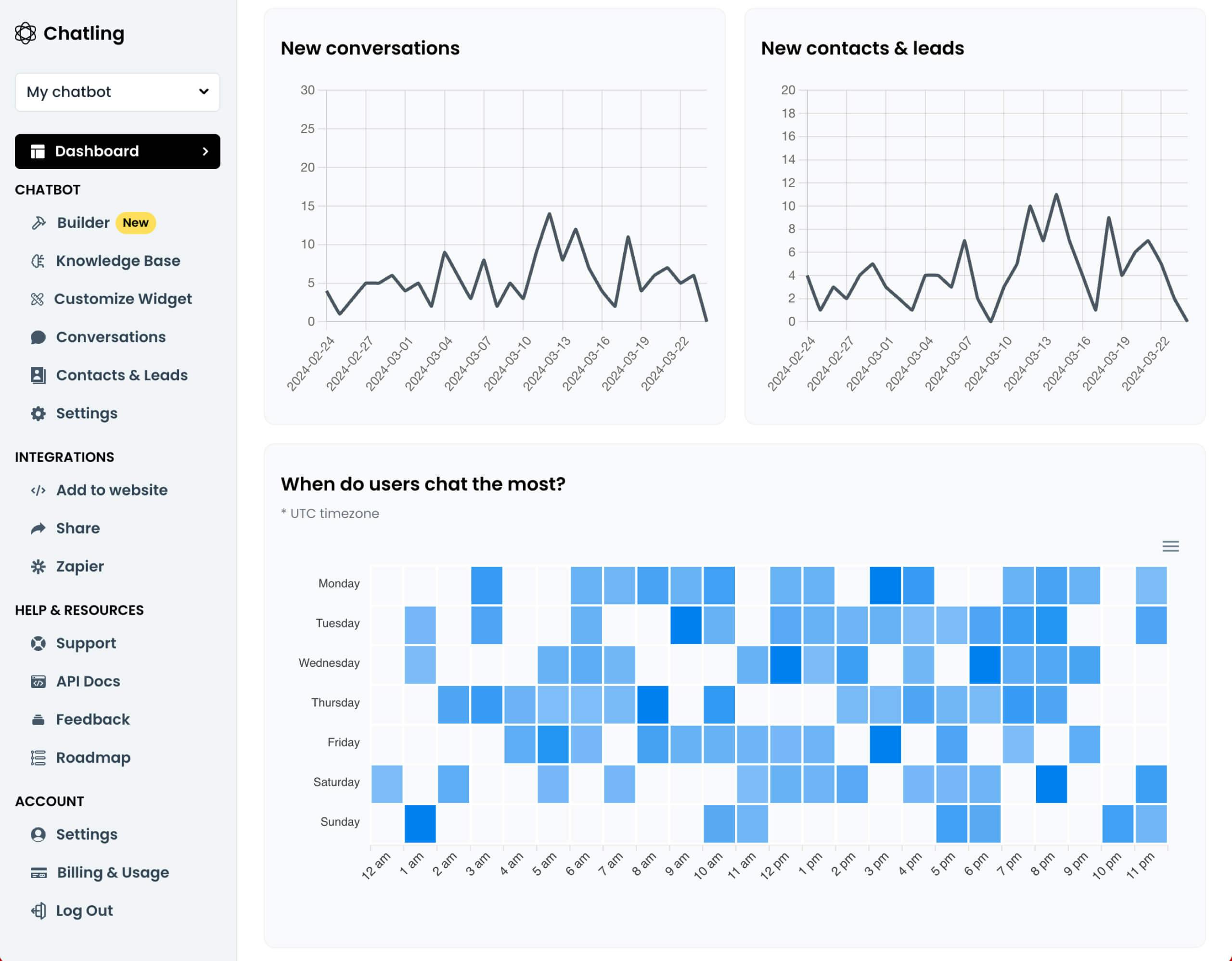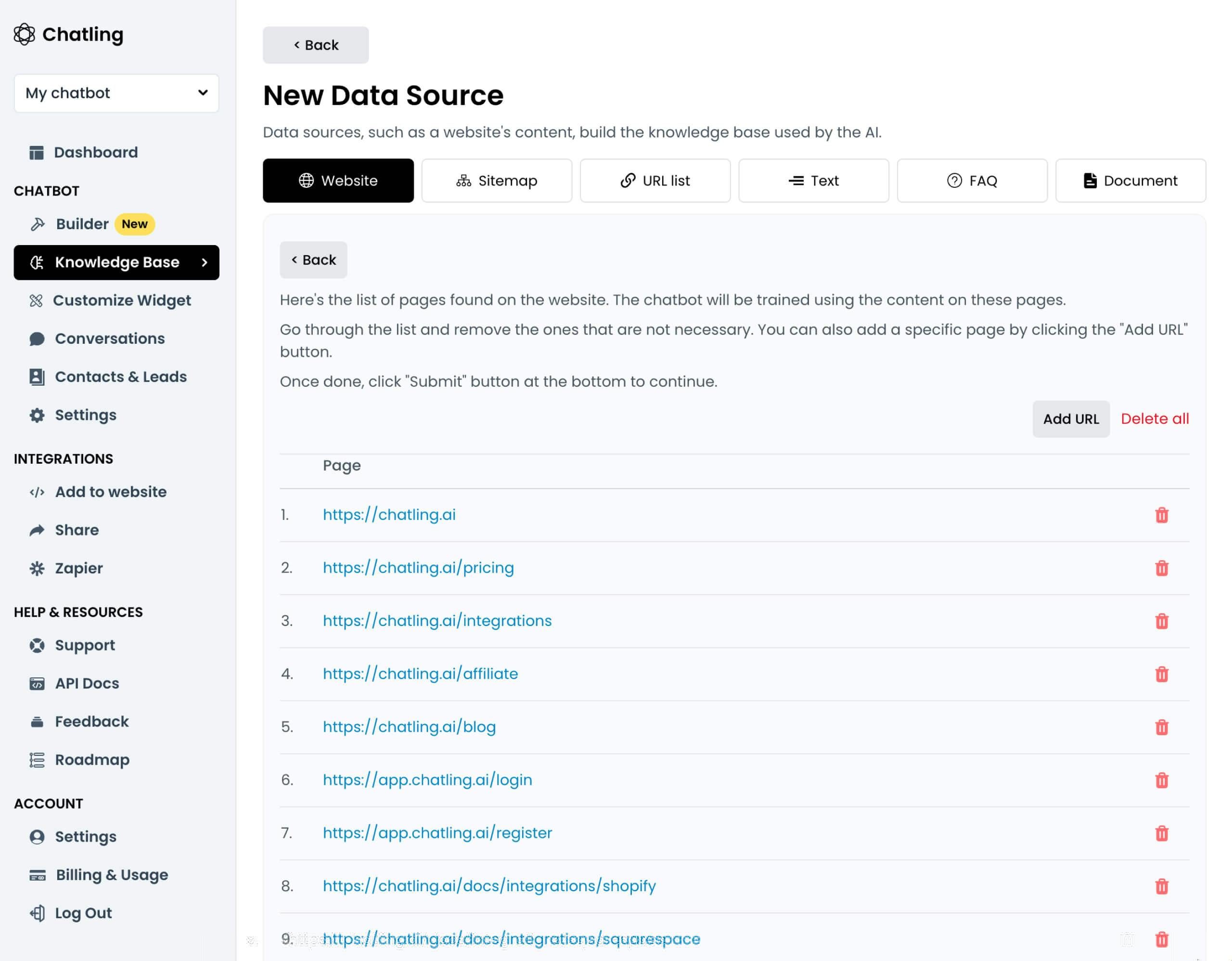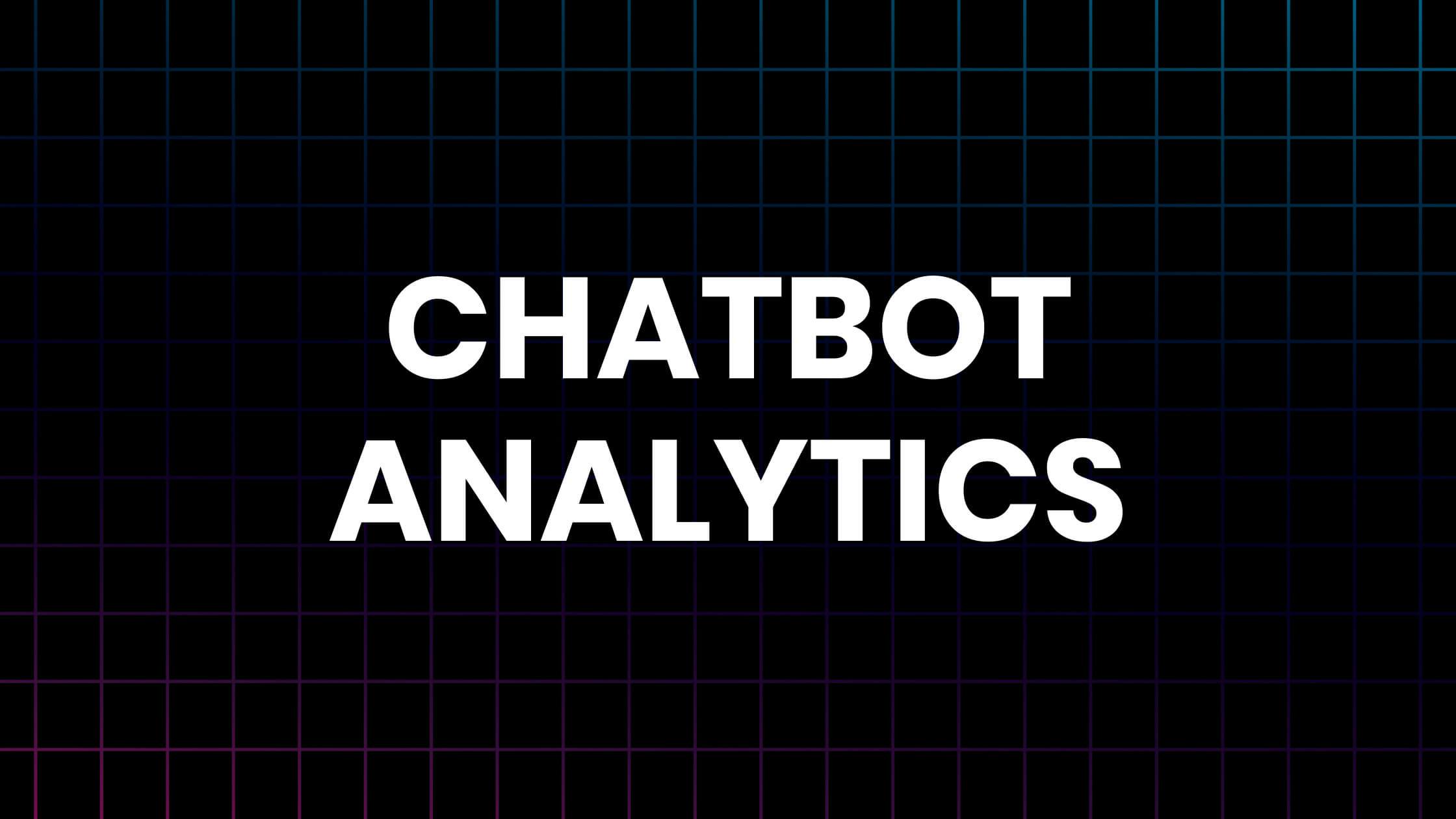Helpful Summary
- Overview: This article explains the importance of chatbot analytics. We highlight essential metrics that help businesses understand and improve their chatbot performance.
- Why you can trust us: At Chatling, we specialize in advanced AI chatbots that enhance customer interactions. Our platform, trusted by startups and enterprises alike, has successfully optimized chatbot performance and customer satisfaction.
- Why this is important: Tracking chatbot analytics helps measure performance, enhance user experience, optimize support, boost conversion rates, identify trends, improve ROI, and ensure continuous improvement.
- Action points: Monitor key metrics such as user engagement, completion rate, response time, fallback rate, retention rate, conversion rate, and user satisfaction.
- Further research: Visit the Chatling blog to discover more articles on improving customer satisfaction.
- Want to Learn More About Chatbot Analytics?
- Why Listen To Us?
- Why is Tracking Chatbot Analytics Important?
- 5 Essential Chatbot Metrics to Track
- How to Improve Your Chatbot Analytics & KPIs
- 1. Regularly Update Training Data
- 2. Implement Continuous Testing
- 3. Monitor User Feedback
- 4. Optimize Response Time
- 5. Enhance Fallback Responses
- 6. Analyze User Pathways
- 7. Focus on Key Performance Indicators (KPIs)
- 8. Leverage Advanced Analytics Tools
- Transform Your Chatbot with Data-Driven Insights
Want to Learn More About Chatbot Analytics?
Businesses rely on chatbots to streamline customer interactions, boost engagement, and enhance user experience.
But how do you know if your chatbot is truly effective? This is where chatbot analytics come into play.
By tracking and analyzing key metrics, you can gain valuable insights into your chatbot's performance and make data-driven decisions to optimize its functionality.
In this Chatling guide, we'll delve into the importance of tracking chatbot analytics, explore the essential metrics you need to monitor, and provide tips on how to improve your chatbot's performance.
Let’s dive in.
Why Listen To Us?
At Chatling, we specialize in creating advanced AI chatbots that transform customer interactions.
Our platform is trusted by businesses of all sizes, from startups to enterprises, for its powerful features and user-friendly design.

Chatling has become a recognized name in the chatbot development space. So, you can trust us only to share insights backed by real-world success stories and extensive experience in the industry.
Why is Tracking Chatbot Analytics Important?
- Measure Performance: Chatbot analytics provide a clear picture of your chatbot's performance. By tracking various metrics, you can identify areas where the bot excels and where it falls short, helping you make informed improvements.
- Enhance User Experience: Understanding user interactions through analytics helps you tailor your chatbot's responses to better meet user needs. This leads to a more satisfying and engaging user experience, which can increase customer satisfaction and loyalty.
- Optimize Customer Support: Analytics can highlight users' common issues and questions, enabling you to refine your chatbot's scripts and knowledge base. This reduces the workload on human support agents and ensures faster, more accurate responses for users.
- Boost Conversion Rates: By analyzing how users interact with your chatbot, you can identify opportunities to optimize the conversation flow and improve conversion rates. Whether it's for lead generation, sales, or customer onboarding, analytics provide the insights needed to enhance your chatbot's effectiveness.
- Identify Trends and Patterns: Chatbot analytics help you spot trends and patterns in user behavior over time. This can inform your broader business strategy, helping you anticipate customer needs and stay ahead of market trends.
- Improve ROI: Regularly monitoring and optimizing your chatbot using analytics ensures you get the best return on investment. By fine-tuning your chatbot, you can maximize its impact, making it a valuable asset for your business.
- Ensure Continuous Improvement: Analytics provide a foundation for ongoing improvements. By regularly reviewing and acting on data insights, you can continuously enhance your chatbot’s performance.
5 Essential Chatbot Metrics to Track
Let’s take a look at the crucial chatbot metrics you should be keeping an eye on.
1. User Engagement
Track how many users interact with your chatbot. This metric indicates the reach and initial interest in your chatbot.
For instance, if your retail chatbot receives 1,000 interactions per day but only 300 results in completed transactions, it suggests users find the bot initially appealing but may encounter issues that prevent them from completing their tasks.
You can also track the period people mostly interact with your chatbots.
For instance, Chatling's analytics offer a heatmap of chatbot engagement. With our tool, you get to see your chatbot's peak interaction times and identify patterns in user behavior.

2. Response Time
Monitor how quickly your chatbot responds to user inputs. Fast response times are crucial for maintaining user engagement and satisfaction.
An e-commerce chatbot that responds within 2 seconds keeps users engaged and more likely to complete their purchases, compared to one with a 5-second delay.
At Chatling, we provide data showing the average AI response time of your chatbots. These analytics give you insights into how quickly your bot is meeting user needs.
3. Fallback Rate
This tracks how often the chatbot fails to understand user input and defaults to a generic response or transfers the conversation to a human agent. A high fallback rate indicates the need for better training or script improvements.
For instance, if a travel booking chatbot frequently fails to understand queries about flight changes, it may need additional training or script adjustments to handle these specific questions better.
4. Retention Rate
Measure how many users return to use your chatbot over a specific period. A high retention rate indicates that users find value in your chatbot and are willing to engage with it repeatedly.
For example, if a financial services chatbot sees that 60% of users who interact with it for the first time come back within a month, it indicates high user satisfaction and trust in the bot.
5. Conversion Rate
This measures the percentage of chatbot interactions that result in a desired outcome, such as a sale, sign-up, or lead generation. High conversion rates demonstrate the chatbot's effectiveness in driving business goals.
For example, a marketing chatbot with a 15% conversion rate means that 15 out of every 100 interactions result in a new lead for the sales team to follow up on.
Chatling helps track these conversions, providing data on how well your chatbot is driving business objectives, such as new contacts and leads.
How to Improve Your Chatbot Analytics & KPIs
Improving your chatbot analytics and key performance indicators (KPIs) is crucial for ensuring your chatbot delivers a high-quality user experience and achieves your business goals.
Here are some effective methods to improve your chatbot analytics and KPIs:
1. Regularly Update Training Data
Keeping your chatbot's training data up-to-date is crucial for maintaining accuracy and relevance.
Regularly review and update the content it’s trained on, such as FAQs, user feedback, and new company policies.
Chatling, for instance, allows you to easily upload new documents and integrate your website's content to train your chatbot. This ensures your chatbot stays informed and responsive to current information.

2. Implement Continuous Testing
Regular testing of your chatbot’s conversational flows helps identify weak points and areas for improvement. Use A/B testing to compare different script versions and see which performs better.
Analytics tools can help you track the effectiveness of these tests by providing detailed insights into user interactions and response accuracy.
3. Monitor User Feedback
Actively gather and analyze user feedback to understand their satisfaction and pain points.
For instance, our tool's analytics dashboard provides data on the percentage of responses that users found helpful or unhelpful.
You can use this feedback to fine-tune your chatbot’s responses and improve its overall performance.
4. Optimize Response Time
Fast response times are critical for maintaining user engagement.
Regularly monitor your chatbot’s average response time using analytics tools. If you notice delays, investigate potential causes such as server issues or complex queries that require optimization.
Ensuring your chatbot responds quickly can significantly enhance user satisfaction.
5. Enhance Fallback Responses
High fallback rates indicate that your chatbot frequently encounters queries it cannot handle. Use detailed analytics to identify common fallback triggers and refine your bot’s training to cover these gaps.
Enhancing fallback responses can reduce user frustration and improve the overall interaction quality.
6. Analyze User Pathways
Understanding the common pathways users take during their interactions can help you optimize the conversational flow.
Heatmap features in analytics tools allow you to visualize user engagement and identify where users typically drop off. By smoothing out these pathways, you can improve completion rates and overall user experience.
7. Focus on Key Performance Indicators (KPIs)
Regularly review key performance indicators such as engagement rates, conversion rates, and user retention.
Use comprehensive analytics tools to track these metrics and set specific, measurable goals for improvement.
Regularly updating your strategy based on these KPIs ensures continuous improvement and alignment with business objectives.
8. Leverage Advanced Analytics Tools
Utilize advanced features offered by analytics platforms, such as tracking new conversations, monitoring new contacts and leads, and evaluating the effectiveness of AI responses.
These insights help you make data-driven decisions to refine your chatbot's functionality and enhance its performance over time.
By incorporating these strategies, you can significantly improve your chatbot's analytics and KPIs, ensuring it delivers a more efficient, satisfying, and effective user experience.
Transform Your Chatbot with Data-Driven Insights
Tracking and optimizing chatbot analytics is essential for enhancing user experience, improving performance, and achieving your business goals.
By tracking essential metrics and making data-driven improvements, you ensure your chatbot performs effectively and meets user needs.
Ready to boost your customer satisfaction with chatbots?
Explore Chatling and harness the power of our advanced analytics to transform your customer interactions. Get started for free today!
